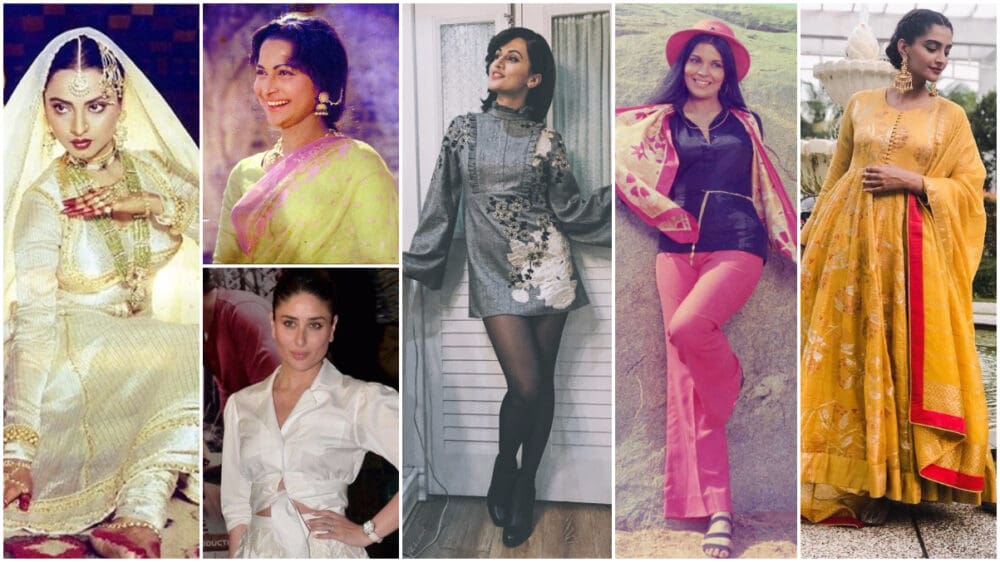Indian fashion is renowned for its rich cultural heritage, traditions, sophistication, and vibrancy. These qualities are reflected in the way Indians dress in traditional attire. It enhances the subtlety and elegance that have persisted for decades. Even though it has grown over time, it is not just comfortable, classy, and aesthetically pleasing. Indeed, with the advent of modernization weeping the world, Indians are not immune to embracing Western along with other styles, however one thing is clear that people in India always stay connected to their roots no matter how far away they live.
Isn’t it remarkable that we Indians really have a plethora of amazing ethnic wear clothing as saree, kurti, lehenga choli, salwar kameez, and so on? Although the first two are only available to women, the third, which consists of a tunic and loose pants, is unisex. Dhoti kurta, lungi, and pagri are all part of traditional clothing for men. Nevertheless, they are simply basic garments; Indian fashion Industry has evolved dramatically since its origin.
Indian textile industry is one of the main segments of the country’s capital goods sector. India is the second largest exporter of textiles in the world, according to a study of the Indian Brand Equity Foundation (IBEF). In addition, favourable demographics and rising income levels are expected to be the primary growth drivers for the Indian textile and apparel business in the next years.
In India, the fashion industry encompasses a wide spectrum of items, from extravagant bridal dresses to casual attire. Chikhan, Zardosi, and Crewel, are classic Indian embroidery styles that have left their mark on the global fashion runway, depicting Indo-western apparel as a combination of the finest of East and West. Besides, India is known for its distinct blend of silk and cotton sarees such as Jamdani, Kanjivaram, Mysore, patola, Banarasi, Bandhini, Sambhalpuri, Paithani, and others.
Evolution of Indian Fashion
Ancient Times:
Stitched garments were not worn in early times such as in the Vedic era. People used to knot their clothing together instead of wearing complete outfits. Surprisingly, the idea of stitched clothes existed even before the Indus Valley Civilization; yet, stitched clothing did not emerge until the Islamic era. The dhoti and saree, therefore, are unstitched traditional Indian garments that are still worn today.
Image source: Scroll.in
Stitched clothing, such as the burkha or hijab, first entered Muslim homes throughout the Islamic era.
During British Raj:
With the arrival of the British in India, western clothing for both men and women became popular. In reality, when it came to fashion, the British era was extremely perplexing. The expanding influence of the British clashed with Indian national identity. The average population continued to wear traditional attire whereas the upper class who had good relations with the British were inspired by their fashion sense, which quickly became a symbol of status.
The era of 1980s and 1990s:
The 1980s and 1990s were marked by an increase in the number of fashion schools in India, as well as a widespread change in Indian clothing style. Also, it indicated a significant growth in the number of women entering the labour force. The emergence of certain sparkly and glittering outfits, leather and denim biker jackets and chiffon sarees in vivid shades with a fusion of Western and Indian fashion trends marked the beginning of Disco in the 1980s.
Full-sleeve salwar kameez, floral dresses, long skirts, denim, sunglasses, and dungarees all made their appearance in the 1990s. Indians are said to have absorbed more westernised fashion concepts in the decades following the 1990s, creating bold and trendy selections. Bollywood, the Indian film industry is, in fact, a significant driving force behind this. Indian fashion has a massive international market due to its appeal and large viewership.
Present Era:
The advent of the twenty-first century witnessed a steady and clear picture of the fashion sector in India. Jeans, pants, t-shirts, short dresses, and bold outfits and fashion became more global as women gained independence. This shift is far more noticeable in the way women wear sarees and blouses nowadays. Women favour sleeveless, puffed sleeve, halter-neck, and back-button blouses, over conventional blouse styles. Men now wear t-shirts, shirts, pants, jeans, shorts etc. Today’s leading national brands include Van Heusen, Allen Solly, Raymonds, Louis Philipe, Arrow, Charagh Din, and so on. The branded clothing industry is expanding as a result of increased demand for denim. Many international denim labels, such as Seven Jeans, Pepe Jeans, Levi Lee, and others, have joined the Indian market. Branded clothing has made an important contribution to the development of the Indian fashion sector.
Conclusion:
Nowadays, Indian fashion designers such as Sabyasachi Mukerjee, Ritu Kumar, Manish Malhotra, Tarun Tahiliani, Rohit Bal, and others frequently appear at international fashion weeks.
In many ways, the arrival of fusion clothing has changed the Indian fashion industry. In the last few years, a mix of indo-western, modern, and vintage has been extremely popular. It has progressed to the point that top-tier fashion labels include the same feature in their collections. With the emergence of long maxis with collars, Palazzo Suits, crop-tops, Anarkali dresses ready-to-wear sarees, and tunics, fusion wear is gaining huge appeal. On the other hand, indo-western shirts, spaghetti kurtas and lehengas, are attracting a lot of attention.
International designers and businesses have influenced India’s fashion trend, as well as introducing the concept of corporate wearing. The corporate look has sustained to this day, with fusion wear adding a touch of modernisation. The Indian fashion business has grown to the point where it is now on par with the worldwide fashion industry and is one of India’s most popular revenue-generating enterprises.
To summarise, the Indian touch is everywhere; whether it is culture, religion, art or clothing, India has always had an impact on the world.
References:
https://www.desiclik.com/indian-fashion-history-evolution-influence-pg-30.html
https://www.iiad.edu.in/the-circle/evolution-fashion-industry-india/
https://www.textilemegastore.com/blog-importance-of-traditional-indian-ethnic-wear-for-festivals
Featured Image Source: southindiafashion.com
By Somasree Roy

